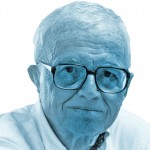
I studied the photograph on the front page of The New York Times—two standing figures—as if I were puzzling out an ancient glyph. What kind of society practiced such an odd tribal rite? The caption said: “Tina Brown with Stephen Colvin, chief of the Newsweek-Daily Beast Company.” Ms. Brown, the high-buzz former editor of Vanity Fair and The New Yorker and of the defunct Talk, had once again reincarnated herself—as editor of Newsweek, a hybrid formed by merging the dying 78-year-old newsmagazine with her own dying website, The Daily Beast.
The first issue was due out momentarily, and in her Times interview—during which, “between answering questions, she clicked through her BlackBerry scanning e-mail”—Ms. Brown described the recent whirlwind of prenatal staff discussions. “It is not uncommon,” the Times said, “for her senior editors to find themselves barraged with e-mails predawn or on weekends.”
What puzzled me about the Times’ caption was the preposition “with,” suggesting that Ms. Brown and Mr. Colvin were chatting about their imminent baby. But in fact, though the two moguls were “with” each other, standing barely apart, both of them were sending text messages, thumbs fully engaged. They were “with” someone who was somewhere else.
Looking at the two texters, I wondered: Why aren’t these people talking to each other? I also wondered if they were enjoying their work. That used to be a big reason why people became journalists: to give themselves—and their readers—a good time. That bug bit me when I was a young boy reading of the New York Herald Tribune, which I would spread out on the rug because I was too small to hold it open. I marveled that a paper existed that seemed to have been written just for me. Its articles usually had an extra touch of humanity or humor—some gift of themselves that the reporters were offering to the world—and I knew that that’s what I wanted to do. I’m still trying to do it.
Home from World War II, I landed a job with the Herald Tribune and found myself in the same room—the vast and grimy city room—with the giants who first put that boyhood dream in my head. They were a mixed bag of mavericks and oddballs, unsurprised by human oddity. Nobody gave it a second thought when Lucius Beebe, the legendary fop, who covered “café society,” arrived for work in midmorning wearing a derby, a bespoke suit, a magenta shirt, a white silk tie, and a figured vest with a gold watch and chain, or when the absent-minded music editor Francis D. Perkins, who often smoked his pipe upside down, started another paper fire in his wastebasket. We were a community held together by the common purpose of our daily voyage.
We spent far more time at the water cooler than our kidneys required, endlessly talking shop. None of us ever received a message from the executive editor predawn. George Cornish was a broad and cultivated man, and I can safely bet that at “predawn” he was fast asleep and that he later had a leisurely breakfast, reading the day’s news and thinking about the world that his paper would have to navigate when he got to the office.
Many years later, when I wrote a column for Life, I learned that if certain editors had to be consulted it was wise to do so before their three-martini lunch. But the magazine always came out, and it conveyed a sense of high enjoyment. It was the glue that held America together before television came along.
I won’t try to guess what nostrums of modern psychopharmacology lurk in the handbags and desk drawers of modern journalists. It wouldn’t be easy to work for bosses who are chained to every last e-mail, text message, and tweet. Such bosses leave their writers and editors no breathing room. Didn’t anyone tell them that oxygen is the spark of life?

